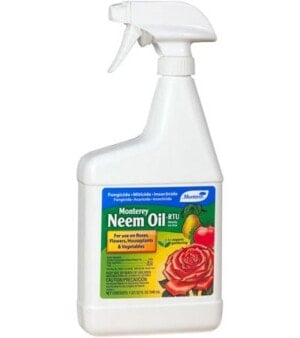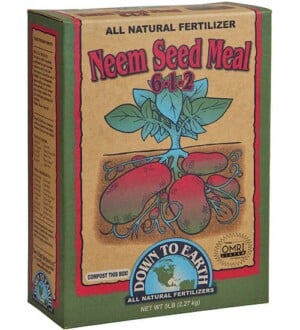Neem oil is an ideal natural pesticide and fungicide that every gardener should have in their toolkit.
It’s a natural solution that can be used on indoor and outdoor plants to get rid of a variety of garden pests. However, there are certain things to keep in mind when applying it to your plants.
Learn all of that and more in this article including how neem oil works, when to use it on plants, and what kind of fungal diseases and pests it can kill.
What is Neem Oil?
Neem oil, one of nature’s best ways to deal with problem pests, is pressed from the fruits, seeds, and bark of an evergreen tree (Azadirachta indica) that grows in South Asia, especially India, and parts of Africa.
Need seed oil, known in Sanskrit as Sarva Roga Nirvani or ‘cure of all ailments,’ has a long history of skincare and medicinal uses.
Because of its nourishing, acne-fighting qualities, it’s often found in specialty soaps and other modern skin products.
Neem is best known as an organic method for controlling pest infestations.
The compounds contained in the oil work in many ways against many insects, interfering with their reproductive cycles, inhibiting their feeding, serving as a repellent, and, with some pests, as a contact-insecticide that kills them outright.
Neem oil is safe to use around pets and indoor plants, according to the environmental protection agency (EPA).
Other neem oil products include insect repellent essential oil blends and neem cakes, a type of soil amendment.

IT'S ORGANIC!
Neem Oil - RTU
An easy to use, ready to spray formula that works both indoors or out.
$14.95Learn more
How Does Neem Oil Work?
Neem oil, applied as a foliar spray or ‘leaf shine,’ is especially valuable to indoor and hydroponic growers. The spray prevents fungus and other leaf diseases. It’s particularly effective against spider mites, indoors and out.
Most neem oil comes from the tree’s crushed seeds mixed with a solvent such as alcohol or with water. As with cooking oils, cold-pressed is best for organic gardening purposes.
The different methods of processing determine the strength of the oil’s active ingredients.
Azadirachtin is the most common compound extracted from neem seed and other parts of the tree. Azadirachtin is combined with soaps or other organic-listed compounds in all-around insect sprays.
It’s also available as a stand-alone extract to combat various kinds of mites, moth larvae, and beetles. It works by disrupting the pest’s hormones that control breeding, growth, and feeding.
Azadirachtin isn’t the only compound in neem oil thought to be useful in pest control.
Cornell University’s Resource Guide For Organic Insect and Disease Management says that oil from the neem tree contains over 70 compounds in its oil, many of them thought to have insecticidal or repellent properties.
The Resource Guide cites a 1995 Washington State University study that showed products containing “both azadirachtin and neem oil have greater efficacy in controlling aphids than either ingredient alone.”
When to Use Neem Oil on Plants
Neem oil can be used to keep pests away and to get rid of pests that are already there in an existing infestation.
Use neem oil in the morning and evening. Don’t use neem oil in the middle of the day, because the direct sunlight and neem oil together can burn the plants.
Neem oil works all through the growing season because it can kill pests at every stage of their life cycle, including when they are eggs, larvae (grubs), pupas, and adults.
What Kind of Pests Does Neem Oil Protect Plants Against?
Neem oil is effective against some of the most common and difficult-to-control bugs and insects that gardeners face.
According to The Gardener’s Guide To Common-Sense Pest Control, these include the Colorado potato beetle, Mexican corn beetle, whitefly, spotted cucumber beetle, corn earworm, flea beetle, and cabbage looper.
Other insects that it’s capable of killing include fungus gnats, thrips, Japanese beetles, and mealybugs.
It’s also been shown to repel and disrupt the life cycles of spider mites and root-knot nematodes. These life cycle disruptions lead to reduced populations and eventually extermination.
Overall, neem is reported to inhibit the feeding of 170 insect species and inhibited the growth of insect species in four different orders. In addition, it’s directly toxic to aphids, termites, and various caterpillars.

OMRI LISTED
Neem Meal (6-1-2)
Stimulates microbial activity and is excellent for boosting root systems and root crops.
$15.95Learn more
What Kind of Fungal Diseases Can Neem Oil Kill on Plants?
Neem oil is effective against many fungal diseases and infections including powdery mildew, black spot, rust, sooty, mold scab, anthracnose, and leaf spot.
Is Neem Oil Safe for Beneficial Insects?
Surprisingly, neem is thought not to harm certain beneficial insects including ladybugs and predatory mites, and does not impact honey bees and other pollinators like butterflies as long as they’re not sprayed directly.
Earthworms are also unaffected by its compounds. The National Pesticide Information Center reports that neem is practically non-toxic to birds and mammals.
Because neem contains so many active ingredients and works on insects in a variety of ways, it’s believed that insects will not develop a tolerance to it even with extended use.

Can You Use Neem Oil as A Soil Drench?
Yes, you absolutely can! And it helps in two main ways.
Firstly, when used as a soil drench, neem oil acts as a systemic insecticide. The oil is drawn up into the plant’s vascular system by the roots.
This means that its present throughout the plant’s structure, and harmful insects that feed on your plant will be exposed to it.
And secondly, neem oil drench is also thought to reduce nitrogen release, leaving more nitrogen in the soil for uptake by nearby plants.
How To Use Neem Oil for Plants?
Because neem can disrupt insect growth and feeding patterns, it is best used when insects are young and in their early stages.
Neem doesn’t work immediately when it affects insects this way. Don’t expect to see instant die-offs but do look for a decrease in pest numbers.
Sprays take time to work — apply frequently.
Neem lasts only a few days in the environment so weekly sprayings are recommended. Be sure to spray on both sides of the leaves.
Mix concentrates as directions specify. As an oil, neem does not dissolve, nor do its compounds. Be sure to stir mixtures frequently to maintain strength.
Make no more than you’ll use. Neem, once diluted, doesn’t keep long.
Have extra when done applying? Spray liberally on cucumber plants to discourage disease.
Neem oil may also be used on the ground where it will be taken up by plants. While neem persists longer when taken up by plants than it does sprayed on its surface, it still doesn’t stay effective long.
Refrain from using ground applications a week before harvesting any plant meant for consumption. It’s reported to be strongly bitter and can affect flavor.
Applying neem oil to plants starts before they are set out in the garden makes the plants less likely to experience problems down the road.
What Plants Should You Not Use Neem Oil On?
Neem oil shouldn’t be used on herbs such as basil, caraway, cilantro, dill, marjoram, oregano, parsley, or thyme.
Spraying neem oil on plants with delicate or wispy leaves, such as arugula, lettuce, peas, and spinach, should be done with caution because it can cause foliage burns.
Products containing neem oil are frequently labeled for a wide range of crops, including herbs, vegetables, fruits, nuts, and ornamental plants. Make sure to read the label to follow the correct instructions.
Regardless of the plant being treated, neem oil can cause plant damage by burning the foliage. Do not use it on newly transplanted or stressed plants.
Although plants must be completely covered in neem oil for the pesticide to be effective, it is best to test the product on a small area first.
If there are no toxicity symptoms in that area, the entire plant can be treated.
How to Mix Neem Oil Spray for Plants
To make your own neem oil insecticide spray, you’ll need a spray bottle, cold-pressed neem oil, liquid soap, and a gallon of water.
Here’s how to make it:
- Mix together water and a small amount of soap. Mix one gallon of warm water with one teaspoon of liquid soap. It will serve as an emulsifier to help mix the neem oil.
- Next, add one to two tablespoons of neem oil to it.
- Apply your neem oil mixture to a small section of your plants using a foliar spray bottle. Allow twenty-four hours. If the mixture causes no damage, thoroughly mist your indoor and outdoor plants, spraying directly onto plant leaves.
- As a preventative measure, apply neem oil every two weeks. Spray your plants with neem oil once a week if you’re trying to control an active pest infestation.











